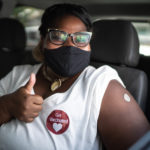
By Pamela Miller, OD, FAAO, JD, FNAP
April 28, 2021
Vaccine hesitancy is common. A recent NPR/Marist poll found that one in four Americans said they would refuse a coronavirus vaccine outright if offered. Another 5 percent are “undecided” about whether they would get the shot. Some of those people may work for your practice. Here is how to encourage employees to get vaccinated against COVID.
Get Vaccinated Yourself & Talk About Your Experience
Have you already gotten vaccinated against COVID-19? You have an opportunity to lead by example. Be sure your employees know that you did, and talk to them about your experience. For example, let them know about the side effects, if any, that you experienced, and let them know if you experienced no side effects at all except a sore arm. You also can tell them what the process was like. Discuss how you got your appointment and what the vaccination center, or healthcare facility, was like where you got your shot. If it was an efficient, pleasant experience, let employees know how easy and convenient it was.
It also is helpful to tell employees why you wanted to get vaccinated yourself and why you feel vaccination against COVID is so important.
Reassure About Effectiveness and Safety
There is tremendous misinformation circulating about the COVID-19 vaccination. Take time to educate employees about the truth, including sharing information about the safety and approval measures that are in place when a new vaccine comes on the market, and the trials that took place before the COVID vaccines in use in the U.S. were given the green light. Click HERE for a site developed by WebMD to dispel vaccine misinformation.
Part of the protocol of the vaccination process in the U.S. is waiting for at least 15 minutes after receiving the shot, so the healthcare providers at the place where the vaccination was administered can be sure you will have immediate care if you get a rare severe reaction right after receiving the shot. Noting this part of the process may help show employees the care that is being taken to avoid risks to the public’s health, even those risks that are extremely remote.
With the now-lifted pause of the Johnson & Johnson one-shot vaccine in the news, employees who have not yet been vaccinated may have experienced increased anxiety. Yet, with only 15 confirmed cases of blood clots following this vaccine, out of more than 7 million doses delivered in the U.S., the pause was mostly evidence of the impressive caution being exercised in the vaccine rollout. Emphasize for employees that ultimately health authorities decided the benefits of this vaccine greatly outweighed the very limited risks.
You also can let employees know about the millions of people who have already been safely and effectively vaccinated in the U.S. As of the end of April, more than 230 million COVID-19 vaccine doses have been administered, fully vaccinating over 95.9 million people, or 28.9 percent of the total U.S. population. Your employees will see they will be far from the first to be vaccinated, and that many have safely gone before them.
Require Employees to Be Vaccinated
You want employees to understand the value and importance of vaccination, and do it on their own without needing to be told by you to do it. But there may be employees who are not going to get to that point on their own. Unless the employee has a medical waiver from a physician stating that they should not be vaccinated because of potential risk to their health, or have a documented religious exemption, you are within your legal rights as an employer to require an employee to be vaccinated.
Other Articles to Explore
You can frame it for employees by emphasizing their role and yours as providers of healthcare: “We are a healthcare business. Our job is first to do no harm to our patients. Part of our responsibility to patients is creating an office environment in which they will be protected from catching viruses. Getting vaccinated against COVID-19 is one of the most important ways we can do that.”
If the employee pushes back, and says they are still uncomfortable about getting vaccinated, don’t be afraid to enforce vaccination as a condition of employment: “I understand your feelings, and it’s your right to feel that way. However, vaccination against COVID-19 is a rule in our office for which there are no exceptions barring a medical waiver or religious exemption.”
Put the Vaccination in Context with Your Larger COVID-19 Prevention Protocol
Employees in your practice are used to enforcing safety measures to prevent the spread of COVID-19. They have been doing these things for over a year now. Put the vaccination requirement in the context of all the other safety measures, such as masking, social distancing and sanitizing surfaces, office supplies and frames, that you and your employees have been doing for a while now.
Your COVID prevention protocol should already be part of your Employee Manual. Add the vaccination requirement to that protocol. That way this new requirement will be formally documented, and employees will interpret it as no different from wearing a mask while inside the office. Just as they would not be allowed to work in the office without a mask on, they will not be allowed to work in the office without getting vaccinated against COVID. Click HERE to see the COVID prevention protocol in my office. Note #7 in the list of protocols.
I ask for a copy of each employee’s vaccination card to keep in our human resources files, so we have documentation of the safety measures we have taken in our office.
Reinforce Good Behavior: Say Thank You After They Get Vaccinated
When employees do the right thing, helping to ensure the welfare of patients and their colleagues, you can reinforce good behavior by saying thank you. I gave each of my employees a $50 check as a way of showing my appreciation for making our patients and families safer. They did not know in advance of getting their vaccination that they would receive this gift. I wanted my employees to know that I recognize and appreciate the importance of their actions.
 Pamela Miller, OD, FAAO, JD, DPNAP, has a solo optometric practice in Highland, Calif. She holds a law degree and a therapeutic license, is California State Board-certified and glaucoma-certified to prescribe eye medications, and offers comprehensive vision care, contact lenses, visual therapy and low vision services. To contact her: drpam@omnivision.com.
Pamela Miller, OD, FAAO, JD, DPNAP, has a solo optometric practice in Highland, Calif. She holds a law degree and a therapeutic license, is California State Board-certified and glaucoma-certified to prescribe eye medications, and offers comprehensive vision care, contact lenses, visual therapy and low vision services. To contact her: drpam@omnivision.com.

























